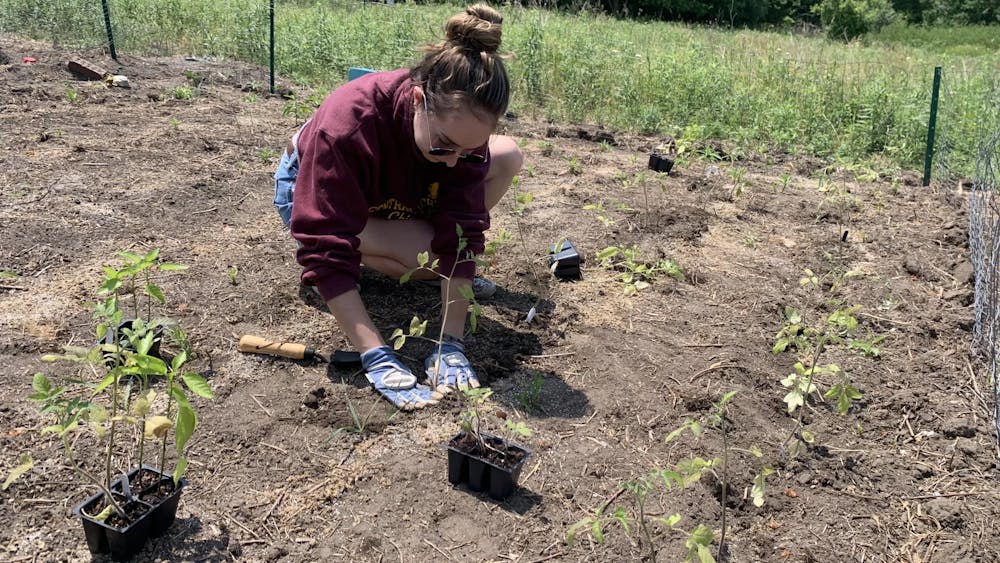Living legacy
Mount Pleasant to preserve a living history of Hiroshima

Mount Pleasant is currently home to living relics of one of the most notable tragedies of the 20th century. The only of their kind in Michigan, Ginkgo tree saplings descended from those that survived the bombing of Hiroshima may become a cultural fixture of the city, if they can also survive a Michigan winter.
Central Michigan University professor and faculty member Hope May acquired the seeds from a program called Green Legacy Hiroshima. Founded in 2011, Green Legacy Hiroshima’s website reads that seeds and saplings have been distributed to over 40 countries with the objective of representing the dangers of nuclear weapons, the character of mankind and the resilience of nature.
Over the course of this project, which spans over a decade, May said that she learned of the significance of peace and reverence for nature in Japanese culture. These values were evidently displayed through the tending to and pruning of the wounded trees that had survived the bombing of Hiroshima.
“The notion of peace culture is something that is part of the DNA of Hiroshima,” May said.
Current CMU alum Eric Urbaniak was one of the founders of the Ginkgo tree seed initiative and an integral part of the planning process, May said. As the trees were not approved to be planted on CMU’s campus, Urbaniak fostered the connection between Central Sustainability, a student-run office on campus dedicated to increasing sustainability, and the city of Mount Pleasant.
The first round of seeds were cared for in the greenhouse on CMU’s campus, monitored both by May and Greenhouse coordinator, Karin Johnson. The initial plan for the seeds consisted of growing them in the greenhouse for one year, then being relocated to Nelson Park as a part of the 2024 Earth Day celebration.
Despite the diligent efforts of May, Johnson and the students they worked with, the first batch of seeds did not germinate, and the process had to begin again.
Taking a different approach to the sapling’s care, May has been personally housing the seeds in an attempt to acclimate them to the harsh realities of Michigan’s seasons as opposed to raising them in the greenhouse’s controlled environment.
“It’s just deeply symbolic,” May said. “It’s rooted in history. It’s a multilayered, multidimensional lesson. I go out there on the balcony in my house and I look at them every day to see how they’re doing and I see little green buds on the stem.”
As the plants emerge from their first winter outdoors, May is cautiously optimistic about their fate. She said that imagining that the trees will live for generations is a fragile thing and systems need to be put in place to ensure that is able to happen.
“Part of the symbolism and the importance of the story is the importance and necessity of care and attention to something of value,” she said. “We can’t just take for granted that these seeds are going to make it.
“This is a process of caring for stewarding and bringing up a life force, if you will, because that’s what a plant is, that has been protected and cared for on the other side of the planet by a people who suffered something truly horrible that we, the United States, did. So there’s many, many layers to the story.”
While May watches over the saplings’ progress, long-time member Tiffany Jurge and her fellow coordinators at Central Sustainability continue to contribute their efforts to the initiative in an administrative role.
Though Jurge’s initial reaction to the first batch of Ginkgo trees was fear of radioactivity, she now takes on a leadership role in the project.
“If at some point the seeds are able to germinate and we can get them planted, I envision a role with CS to help with the actual planting in the park, to gather people around and share it with the rest of campus,” Jurge said. “That’s our role too, outreach, actually doing the project, and doing tours to showcase the saplings to the community.”
Jurge and her team coordinate with city officials and CMU faculty on a regular basis to ensure that when the time comes for the saplings to be planted, CS and the city will be ready. Their efforts are supported by Mount Pleasant’s recently appointed mayor, Boomer Wingard.
Wingard said that he was first approached about the project in 2023 by May, who was a professor of his during his time as a CMU student.
Wingard said that Nelson Park was chosen as the preferred planting spot for the Ginkgo samplings due to its ties to Mount Pleasant’s sister city, Okaya, Japan.
Despite the germination failure of May’s first batch of seeds, Wingard remains hopeful that the current saplings will yield results.
“The symbolism of these trees that have survived and are having offspring that are outliving that terrible, terrible time, I think it gives a bit of hope,” Wingard said. “There can be these terrible dramatic points in history that we can grow beyond, that we can work to recover from. Having them here in Mount Pleasant would just be an immense cultural resource.”
Wingard said that he has not received an official timeline of the saplings’ expected planting, yet he understands the patience that the act of yielding new life requires.
“Life takes time,” he said. “We’ll take it one step at a time.”
Recognizing the bombing of Hiroshima as a catalyst for change in the 21st century, Wingard does not take the responsibility of housing its natural remnants lightly.
“To have (the Ginkgo trees) here in Mount Pleasant, at the heart of the state, I think would be a really rich cultural item to bring to the city,” he said. “It would be something that I’d be immensely proud to see finally take root at one of our parks.”



